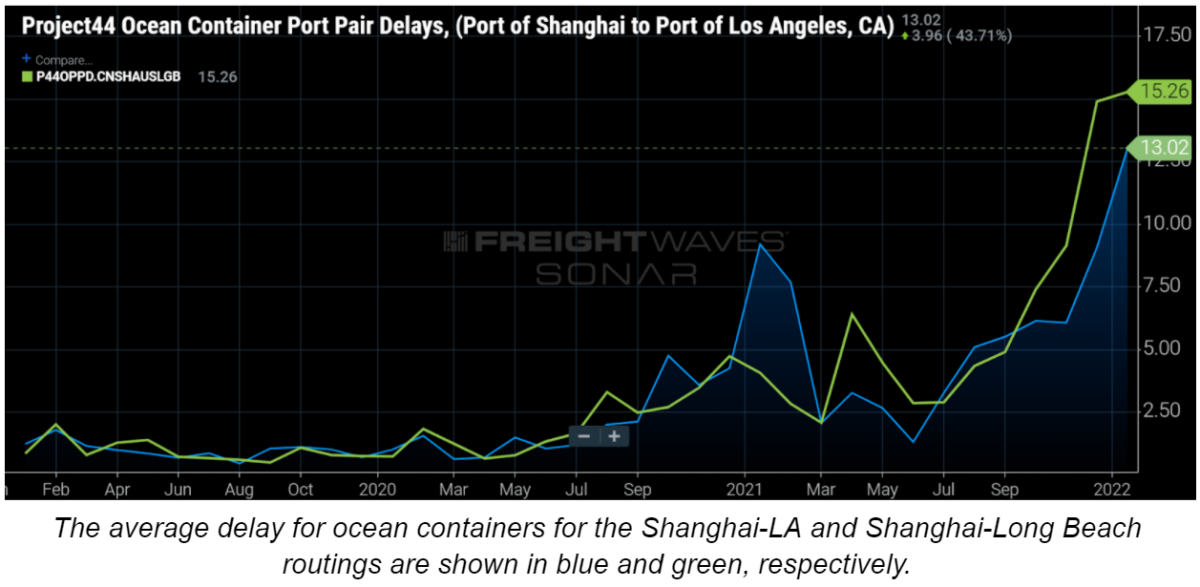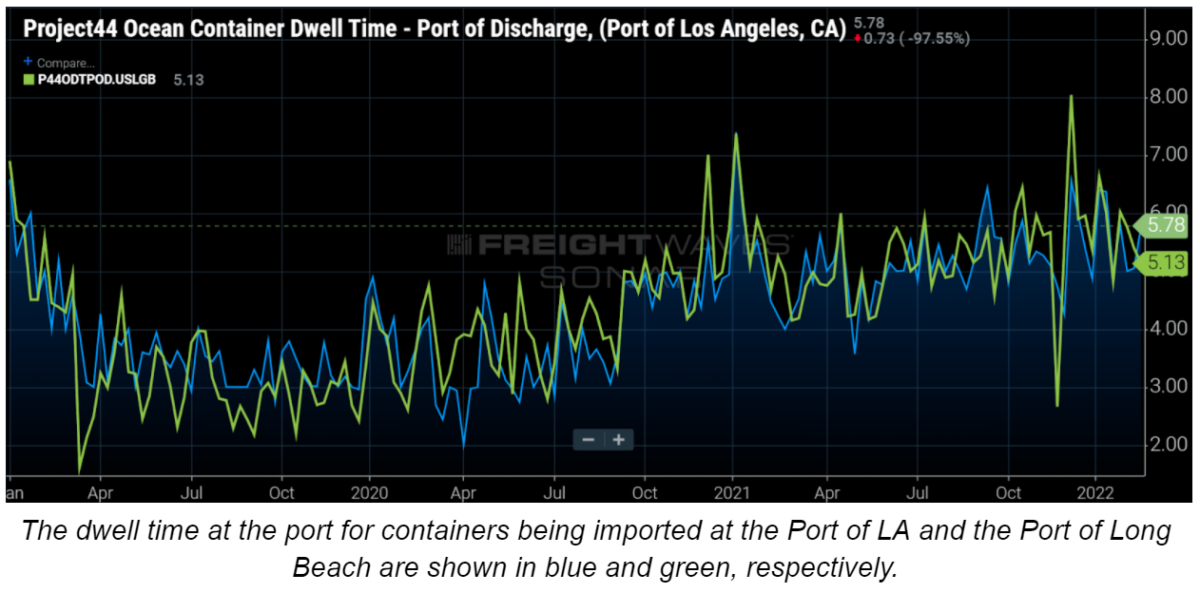Yes, it’s a very good time to be in ocean shipping. But Rolf Habben Jansen wants it to be known it’s not all champagne wishes and caviar dreams as the CEO looks at Hapag-Lloyd’s year ahead.
Habben Jansen didn’t talk about Hapag-Lloyd’s stunning financial performance — 2021 earnings before interest, taxes, depreciation and amortization of $12.8 billion — during a conference call with reporters from global media outlets. He instead devoted most of last week’s presentation to headwinds the German carrier faces.
When will spot rates come down?
Habben Jansen has never claimed to be a soothsayer, but Hapag-Lloyd’s chief was asked time and time again during the call to predict when freight rates would fall from sky-high levels.
“Spot rates are very high at the moment — still — and are likely to remain elevated for some time on the back of strong demand. You see that also when you look at global container volumes,” Habben Jansen said. “There is simply not enough capacity available at the moment on a weekly basis to carry all the demand there is.”
He emphasized that exorbitant spot rates put stress on carriers.
“It’s not only demand that has been strong, but we also have seen that transport expenses have risen considerably,” Habben Jansen said. “On average, ships that you charter are probably four or five times as expensive as they used to be two years ago.
“When we look at bunker, bunker at the bottom was below $200 a ton. Right now we are stretching against the 700 mark,” he continued. “If you look at terminal storage and inland costs, where we’ve also seen a lot of capacity constraints, those have also increased sharply. … When we look at storage costs alone, that for Hapag-Lloyd was more than $400 million more in 2021 than it was in 2020.”
In a nod to Hapag-Lloyd’s profit, Habben Jansen said, “The strong market is certainly reflected in the preliminary numbers that we published last week.” But he noted that “transport volume is largely flat. That is very much congestion driven.”
He was reminded that Hapag-Lloyd had announced last year that it would freeze spot rates.
“We said that we would freeze spot rates at least until the end of the year. That’s also what we have done. We’ve seen a bit of movement on rates since the beginning of this year. In fairness, in some areas things have come down a bit. In some of the nondominant legs, we have followed the market. But we’re still being very cautious in terms of adjusting those rates,” Habben Jansen said.
‘We need congestion to ease’
Rates won’t come down until port congestion in China, Europe and the United States recedes.
“In fairness, we need congestion to ease. That will contribute more to a normalization of the market,” Habben Jansen said, noting that operational challenges, including port wait times and stays at berth, “are still pretty severe.”
Add in a decline in terminal productivity, strained rail connections and a lack of truck drivers, Habben Jansen said, and one can see ports around the world are still a mess.
So too are ETAs.
When will the vessel berth?
“Schedule reliability is still industrywide at a poor level,” Habben Jansen said. “We have set for ourselves the objective to get up in those rankings and we actually did that. The problem is that still doesn’t help the customer all that much because the average in the industry is so much down. … We have to do better and so do our peers around updating our customers on what’s happening. But the reality is it will take some time before schedule reliability returns to the levels that we have seen before.”

He said Hapag-Lloyd has taken a number of actions to mitigate the impact on customers.
“We’ve ordered quite a lot of additional boxes. Today we operate a fleet of around 3 million TEU in box capacity, whereas that used to be 2.5 million. We thought with that 3 million we’d move more or less the same number of containers we did with the 2.5 million, which illustrates how much congestion there actually is.
“Of course we have moved capacity to where it is needed most. We’ve tried to do whatever we could to reroute cargo. We have ordered some new ships. We also have opened up new offices, have added workforce and have added quite a lot of IT capacity,” Habben Jansen continued.
“The strained supply chain will remain a problem as there also is strong demand. We also see there are serious backlogs in several industries. Rating tables will probably remain elevated for a while. The only thing we can do at this point is to take countermeasures as much as we can to keep the impact on our customers as low as possible.
“The key question always comes: ‘When do you think that the market is going to ease?’ I’m still cautiously optimistic that we will see an easing in the market in the course of 2022, the main logic behind that being that once we get beyond the current omicron wave of COVID, most people should be able to get back to work. And once labor is available again as it used to be at terminals and also inland locations, we will start seeing an easing of the congestion,” Habben Jansen said.
He disputed any notion that ocean carriers are reducing capacity to keep rates high.
“Everything we have sails. Every box we have we try to move. Every ship we have we try to sail. And we try to do our utmost to secure more ships, even if sometimes it’s very, very expensive. We certainly don’t hold anything back,” Habben Jansen said.
With the containers purchased in 2021, Hapag-Lloyd now has what Habben Jansen said was a “20% buffer.”
“I certainly hope we don’t have to buy as many boxes this year as last year because the turns of the equipment have already gone down to a level that we have not seen for a very, very long time. I do not expect that we — and the same for many of our competitors — will have to invest a lot in new containers these days because there is already in reality quite a bit of buffer in the global fleet. I mean, normally the amount of cargo that we carry today, we would need about 2.5 million TEU of container capacity. Today, we have 3.05 [million], I think. So we already have a 20% buffer in the system, and I don’t think we need more than that,” he said.

In the same boat
While it may not invest in containers, Hapag-Lloyd, like other major ocean carriers, is in need of new ships.
“If we take a step back and look at supply and demand and the market, we see the order book has definitely grown, right now about 22% [as a share of the world’s fleet]. Idle fleet is down to pretty much zero. Scrapping is also very, very low. Today pretty much all of our vessels are in use and fully utilized,” Habben Jansen said. “We also have a fair number of ships on order, which will start giving some relief next year.”
Hapag-Lloyd has ordered 10 13,000-TEU ships, five of which it will buy and five it will charter. The first of the newbuilds will be delivered by the end of this year, with the remainder coming in 2023.
Stay in your shipping lane
Don’t expect an announcement from Hapag-Lloyd that it has bought a Pilot Freight Services like Maersk or launched an airfreight division like CMA CGM. The ocean carrier is sticking to what it knows.
“If you look at airfreight forwarding, that is something that is reasonably far from container shipping and we also don’t have that expertise. First of all, we’ve always said we’re not going into sea freight forwarding and also as a consequence airfreight,” Habben Jansen said, adding that “operating an airline is not something we would see as a logical extension of what we are doing.”
He thinks it’s too early to determine whether air cargo is worth the investment.
“If you look at the size of the airfreight operations that some of the carriers are having with four or six or 10 freighters, that does not automatically make you a large global cargo carrier. And as such, we remain skeptical. They may be right. I’m not saying their strategy is not valid. We have chosen not to go into that. We are certainly not the experts of that, and many of our customers will tender their air and sea freight separately and will make the choices that they can make,” he said.
Hapag-Lloyd probably will not be jumping into the M&A fray in any sector anytime soon.
“Many of the prices people are looking for are sort of ridiculous. I’m a firm believer that buying expensive assets is in the long run not a good strategy,” Habben Jansen said. “If we see a good opportunity, we will do something, but if we do not see that, we will not be forced to spend the money.”
Shipping reform
Habben Jansen said in addition to airfreight, he wasn’t an expert on the Ocean Shipping Reform Act introduced in the Senate earlier this month and couldn’t comment in detail on efforts to rein in carriers’ detention and demurrage fees, but “looking into those extra charges and trying to see if we can find better ways to do that is not necessarily wrong.”
However, he reiterated that Hapag-Lloyd also has seen its costs grow dramatically and that in the United States alone, the storage fees it paid terminals last year increased by about $400 million over 2020.
“We face tens of millions of dollars of extra cost every month because of those types of charges that we incur.”
Hapag-Lloyd and CMA CGM ‘temporarily’ steering 2 services away from Savannah
Hapag-Lloyd CEO: ‘We are probably in the peak of the problems’
Hapag-Lloyd orders 6 more 23,500-TEU ships at cost of $852M
Click here for more American Shipper/FreightWaves stories by Senior Editor Kim Link-Wills.







